A No-Index Tag is a directive HTML meta tag that informs search engines about the fact that the link of websites with a no-index tag can not be followed. This is a helpful tool because SEO experts can see which content of a specific website is on search results.
Today’s article will be about the no-index tag. As you can see from the title, we will dive into the no-index tag topic without missing every detail and without making this topic too complicated.
What Is No-Index?
‘’No-Index’’ tag is an HTML meta tag that will not show itself when a website page is indexed. What do we mean by ‘’indexed’’ here? That means this website has been added to the database of search engines, and it will not show itself because you added a ‘’No-Index’’ tag to your website. Just like how we block someone from our social media accounts and that person can not text us or reach us, the same logic applies to the ‘’No-Index’’ logic, too. As long as you do not remove the ‘’No-Index’’ tag from your website, the search engines will consider your website as ‘’insignificant’’. Check the common indexing problems here.
How Does No-Index Work?
No-Index is basically about not involving a certain website in the search engine index. However, we can’t understand the No-Index with a basic explanation.
Let’s look at how No-Index really works in a detailed way:
- Crawlers: Search engines constantly send programs called ‘’crawlers’’ to discover websites. The purpose of these crawlers is to visit website pages through links all over the internet. The more they visit websites, the more they get information about these website pages. Learn how to make Google crawl your website.
- Indexing: When these crawlers visit different website pages, they preserve a certain page’s data. After it gathers data, this data about a page is added to the search engine’s index. As a result, the index is the only reason allowing us to quickly search for what we are looking for.
- Instruction: If a certain website page has a ‘’no-index’’ tag, that basically means these crawlers must ‘’ignore’’ the websites which are including a ‘’no-index’’ tag. As a result, the pages with no index tags will not be a part of the index.
- Recognition: If a crawler visits a random website page, the first thing that a crawler will do, without a doubt, is check on the ‘’no-index’’ tag. If a crawler finds a no-index tag, it will ignore that page. However, if otherwise occurs, then it will be added to the search engine index.
- Search Results: A crawler happens not to add the page’s data to the index, and as a result, that page does not appear in search engine results.
- Crawl Budget Savings: Crawl budget is the process of crawling a random website through a crawler in a certain period. To save the budget for crawling, the network administrator will save that budget for more critical websites.
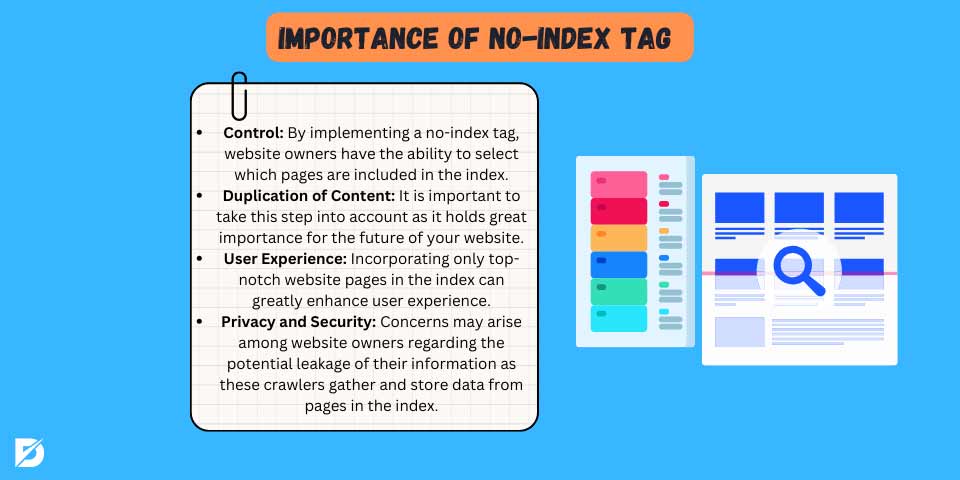
Importance of No-Index Tag
No-Index Tag has an essential role in terms of SEO (Search Engine Optimization) because a crawler program gathers data from every website page worldwide. The data is then preserved in the index with more than millions of data from other website pages. However, you have no idea how this data will be of use. So the question is: How can websites with no-index tags be important? You are about to find out.
Let’s look at why a no-index tag is important:
- Control: A no-index tag allows website owners to decide which one of their pages will be included in the index. Website owners must have control over their own website pages because not every website page may be a part of the index.
- Duplication of Content: You must consider this step because it is crucial for your website’s future. Suppose your website’s content happens to be a duplication of someone’s content. In that case, it will affect your website’s SEO adversely because it will confuse your content with another website’s content, and as a result, your website’s ranking will go down. Using a no-index tag on your website can reinforce the visibility and discoverability of your website page in search results.
- User Experience: If only high-quality website pages are part of the index, it will significantly increase the user experience. If your website’s content is related to what the users are looking for, then that means your website’s content is essential to them.
- Privacy and Security: Since these crawlers are gathering data from pages and storing it in the index, many website owners may think their information has a chance of being leaked. If you decide to add a no-index tag to your website page, you can increase the security level, and you can guarantee the user’s safety.
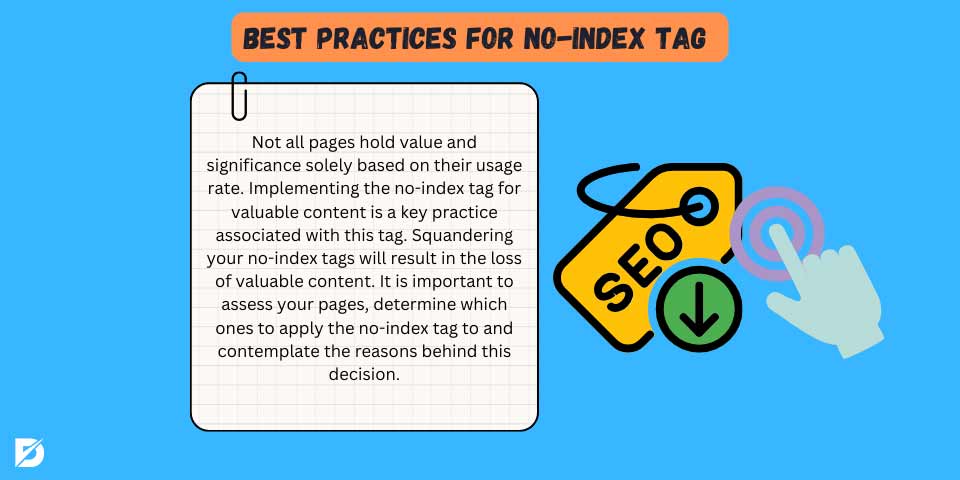
Best Practices for No-Index Tag
As we discussed previously, a no-index tag for websites is important for the SEO management of your website. The reason why a no-index tag is essential for SEO management is because there will be duplication of your content from another website. In time, the duplicated content leads to a decrease in the website visibility. However, there are other practices to implement the no-index tag.
Let’s look at these practices:
- The Usage of ‘’No-Index’’: Not every page is considered valuable and significant because of its usage rate. Using the no-index tag for valuable content is one of the main practices of a no-index tag. Wasting your no-index tags will lead you to lose valuable content.
- Choice: You need to observe your pages, decide which pages you will add a no-index tag, and think about ‘’why’’ you should do that. Before you start doing this, you need to consider your content purposes first.
- Duplicated Content: The reason we added this practice to the list is to show you the importance of duplicated content. As we explained before, if you do not add a no-index tag to your duplicated content from your website, your content will lose its discoverability due to the confusion of other similar content.
- Adding HTML Markup: If you use an HTML meta tag for no-index, you must add in the <head> part of the page’s HTML.
- Important Pages: If you want your page to be discoverable easily in search results, then you must not use the no-index tag for important pages.
- Checking on Status: You can use Google Search Console in order to check on the index status of any website page, including your page.
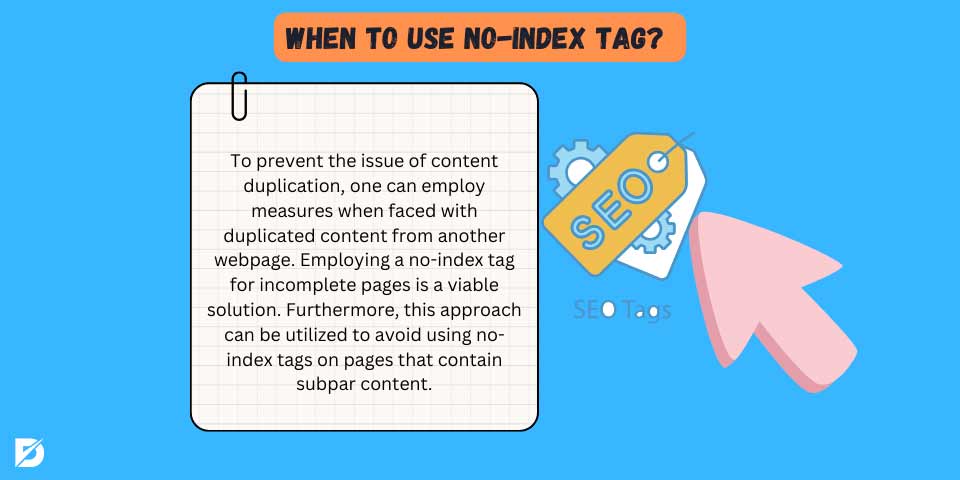
When to Use No-Index Tag?
Now you know how vital the no-index tag is and also know how to use it efficiently the no-index tag. However, if you do not know when to use the no-index tag, it is pointless even if you know the ones we have explained to you previously.
Let’s look at when to use a no-index tag:
- Duplicate Content: You can take precautions about the duplication of content problem if you have duplicated content from another website page.
- Temporary Pages: You can use a no-index tag for the pages which are not completed yet.
- Privacy: You can make the pages with inappropriate content private by adding a no-index tag on these website pages.
- Low-Quality Content: You can use it to avoid using no-index tags on pages with low-quality content.
Robots.txt files
The Robots.txt file is a text file which is providing information to web crawlers all around the internet. Even though the tobots.txt file and no-index tag are two different things, these two can interact with each other.
Let’s look at how they both are working together:
- If your page is not accessible by robots.txt, the crawlers will not attempt to enter that page and will ignore the no-index tag on that website.
- If that page is accessible by robots.txt but has no ‘’no-index tag’’, then the crawlers will enter the website but not add it to the index.
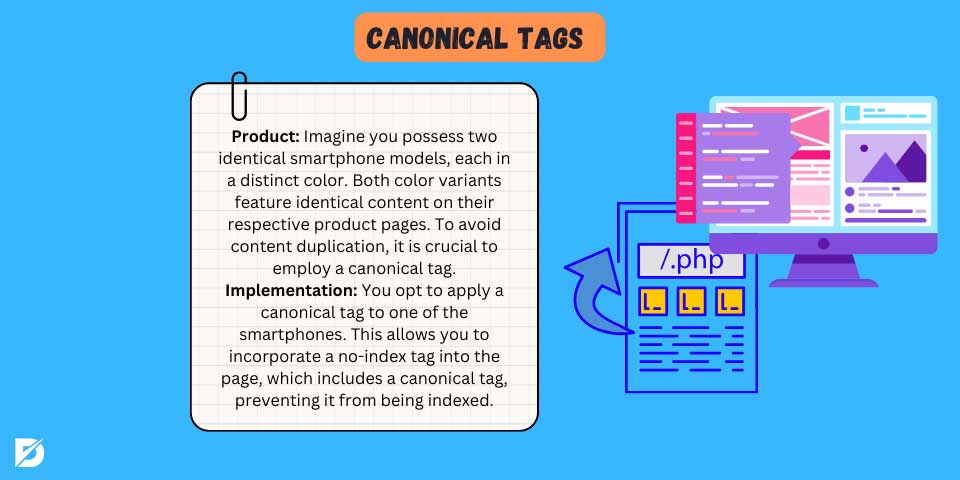
Canonical Tags
Like the same scenario in robots.txt files, canonical and no-index tags have different purposes.
Let’s look at how these two can work together:
- Product: Imagine you have two of the same smartphone models but with two different colors. These two color has the same content on their product pages. If you want to abstain from duplicating content, you need to use a canonical tag.
- Implementation: You decided to add a canonical tag to one of the smartphones. By doing that, you can add a no-index tag to the page, which includes a canonical tag to inhibit from being a part of the index.
Thin or Duplicate Content
No-index tag usage for thin or duplicate content is a helpful SEO method. Here’s why:
- What is Thin and Duplicate Content: Thin content is the pages that are considered insignificant and less valuable. On the other hand, duplicate content is the type of content that appears anywhere on the internet.
- Test: After adding a no-index tag, do not forget to keep an eye on your website’s search engine rankings. Make sure to check that the pages with no-index tags are not part of the index.
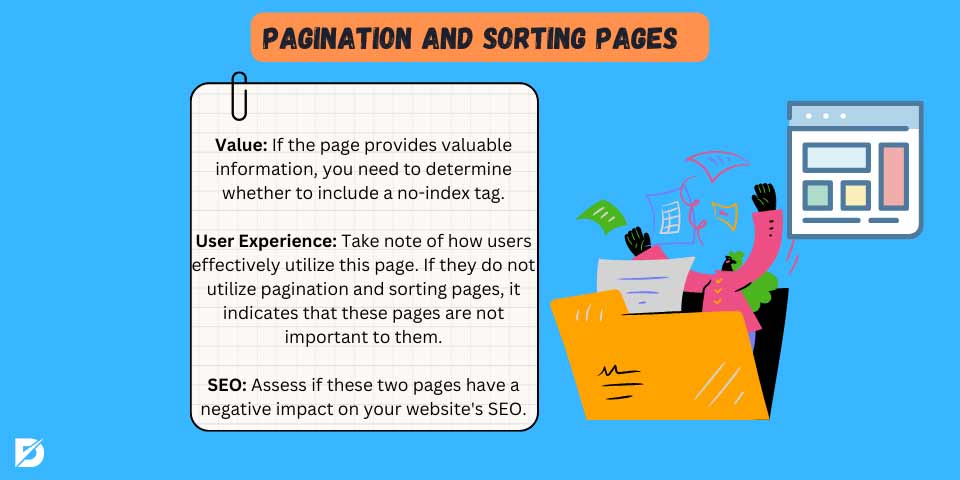
Pagination and Sorting Pages
Pagination pages are always used to divide long content into more short and detailed content pages. Sorting pages lets users filter the content they are looking for. If you want to add a no-index tag to these types of pages, you should consider these steps before adding the tag:
- Value: If that page offers you valuable information, you should decide if you want to add a no-index tag.
- User Experience: Observe how the users make good use of this page. If these users are not using pagination and sorting pages, that means these pages are insignificant to them.
- SEO: You must observe if these two pages adversely affect your website’s SEO.
Content A/B Testing
Using A/B testing with no-index tags requires preparation. Let’s look at how you can use no-index tag and A/B testing together.
- Identify: You need to decide which pages are required to be tested. This can be images, product descriptions, or headlines.
- A/B Test Variants: Create different types of variants that you are going to test.
- Implementing: Use your A/B testing tool to provide your user’s assistance.
Improving Crawl Budget
If you want to configure your website for indexing, you must improve the crawl budget. The most common thing you need to do is decide which pages are essential for you and which ones are less important. So, using the no-index tag for less valuable pages will save your budget.
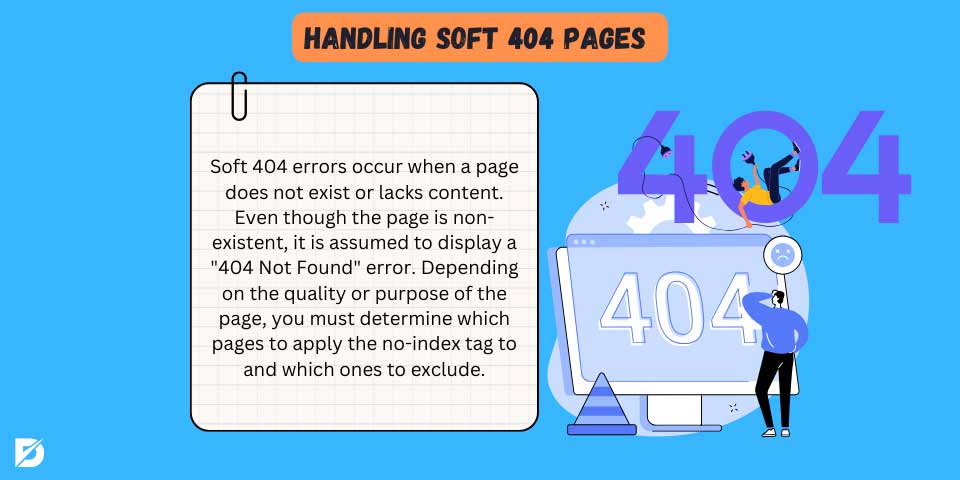
Handling Soft 404 Pages
Soft 404 errors happen when a does not exist or when it has no content. Even if that page does not exist, that page still exists that is assumed to show a ‘’404 Not Found’’ error. Depending on that page’s quality or purpose, you will need to decide which pages you are going to add the no-index tag to or which ones you are not going to add the tag to.
Fixing Website Penalty
No-index tags can be helpful if your website gets different types of penalties, such as low-quality pages, duplication of content, or strange website links from search engines. Adding a tag can be helpful in fixing the penalty.
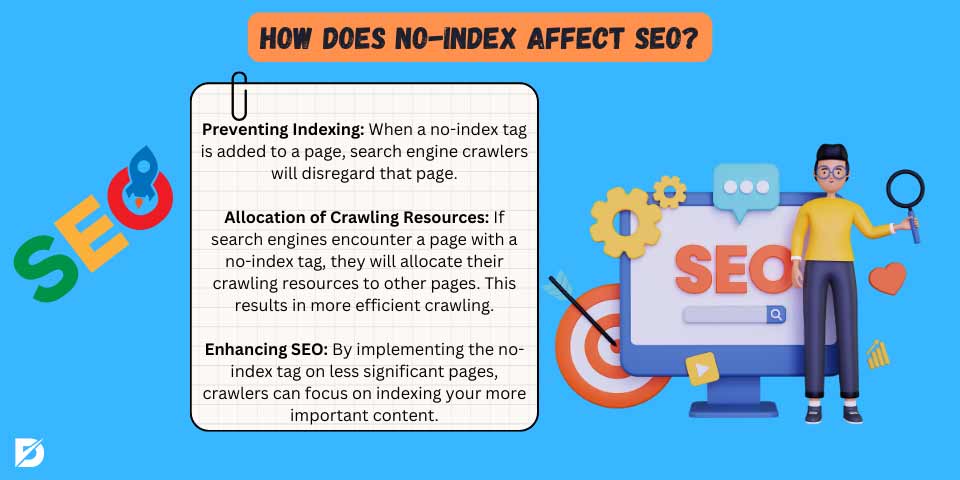
How Does No-Index Affect SEO?
The way you use a no-index tag can have different effects on your website’s SEO algorithm. Let’s look at how the tag can affect SEO:
- Prevent the Indexing: If you add a no-index tag to your page, search engine crawlers will ignore your page.
- Crawling Resources: If search engines stumble on a page with no index tag, these search engines will divide their crawling resources for other pages. This can provide more efficient crawling.
- Improves SEO: If you add a no-index tag to less valuable pages, you can make crawlers target your more critical content.
Don’t forget to take a look at Dopinger’s helpful SEO tools – they are completely free SEO tools you can take benefit of!
No-Index Tag: A Vital Tool
In today’s guide, we explained what a no-index tag is in every possible aspect in order to enlighten you. Since you know when to use the no-index tag and how to use it, you are now one step away from making good use of it for yourself.
Frequently Asked Questions About
A no-index tag is a directive that you can put on your web page and make it not visible to other users.
The most efficient way to use the tag is to prevent duplicate content problems.
The short answer is yes. Search engines will crawl into these no-indexed pages, but they will not include them in the index, and in the end, they will ignore the pages that are marked with no-index tags.
Yes. To do that, you need to use both the tag and robots.txt file together.
By checking the HTML code of your website page.
You can add a tag to inform search engine crawlers to ignore your page, but it is not certain that it will permanently ignore your page.





No comments to show.